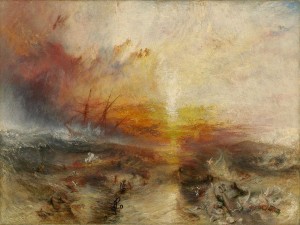In this series, we take a look at how certain seminal and lesser-known artworks have become symbols of social action. Check out Part 1 on Picasso’s masterpiece Guernica here.
Today, we’ll travel back to 1840: J.M. Turner, one of Britain’s most celebrated Romantic painters, reads The History and the Abolition of the Slave Trade and is inspired to depict an account from the book. Though Britain abolished the slave trade in 1833, Turner, like many other ardent abolitionists in his time, wants to continue the anti-slavery efforts around the globe. The result is The Slave Ship, a vibrant and jarring depiction of slaves thrown overboard from a slave ship.

It started with a massacre nearly 60 years before:
Though England had abolished its slave trade, Turner would not let it forget its past horrors, depicting a fictionalized version of the Zong massacre, which took place in 1781. The story made headlines around the world: the crew of the Zong had insurance on its slave “cargo.” When they ran low on water onboard, they mercilessly threw slaves overboard to drown so the others would make it. As if that wasn’t bad enough, the crew then claimed to their insurers for the loss of their “property.” When the insurers refused to pay, the crew took the case to court. Though the insurers eventually won, none of the ship’s crew was ever convicted of murder, despite the best efforts of several abolitionists.
And Turner made his version become history:
Upon its reveal, critics dismissed The Slave Ship as completely unintelligible and unrefined. However, the passage of time has made it clear that these first critics were wrong. The painting shows a terrifying scene: in bright colors, we can see the masts of the slave ship in the distance, fleeing from the wild waves caused by an approaching tycoon. In the foreground, slaves, their arms handcuffed together, attempt to stay afloat in the choppy seas as fish and even some sea monsters circle around them.
In the real story, there was no tycoon, and the slaves were not handcuffed. However, they may as well have been, with their doom sealed as it was. Perhaps most striking, though, is Turner’s emphasis on nature. As a Romantic artist, he believed in the sublime: that is, the utter powerlessness of humanity when face to face with the terror and force of nature. This is shown in the way that the sea and the sky seem to blend together, with the humans — and even the ship — seeming miniscule in comparison to the waves. In this way, Turner emphasizes how hopeless the crew left the slaves, but also seems to subversively imply that the crew would meet their fate as well at some point: the guilty will not be shown mercy. Though this idea infuriated politicians who hoped to put the horrible history of the British slave trade behind them, the painting re-ignited the furor over slavery around the world, and especially in Britain.







